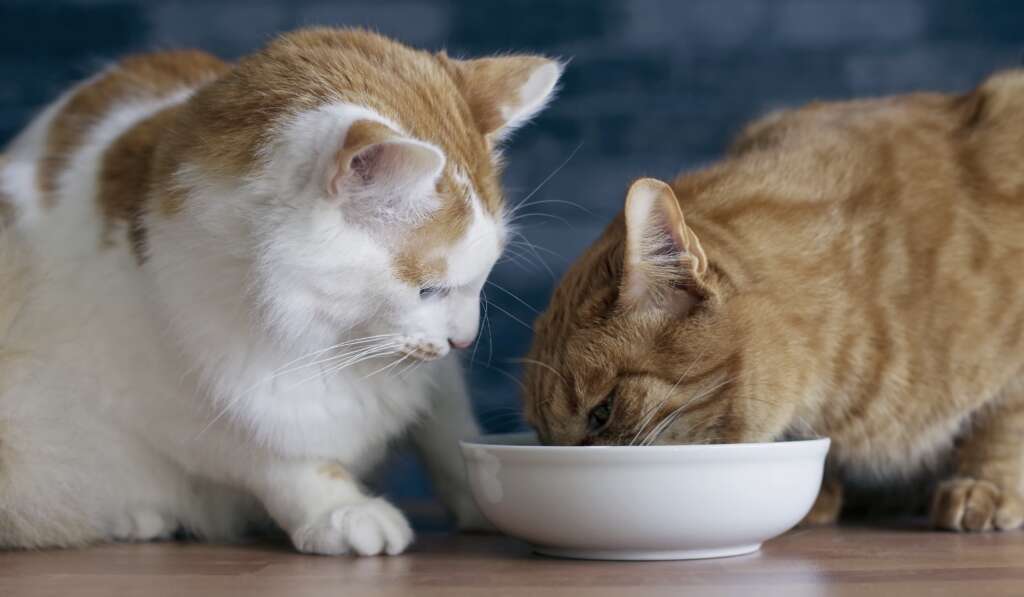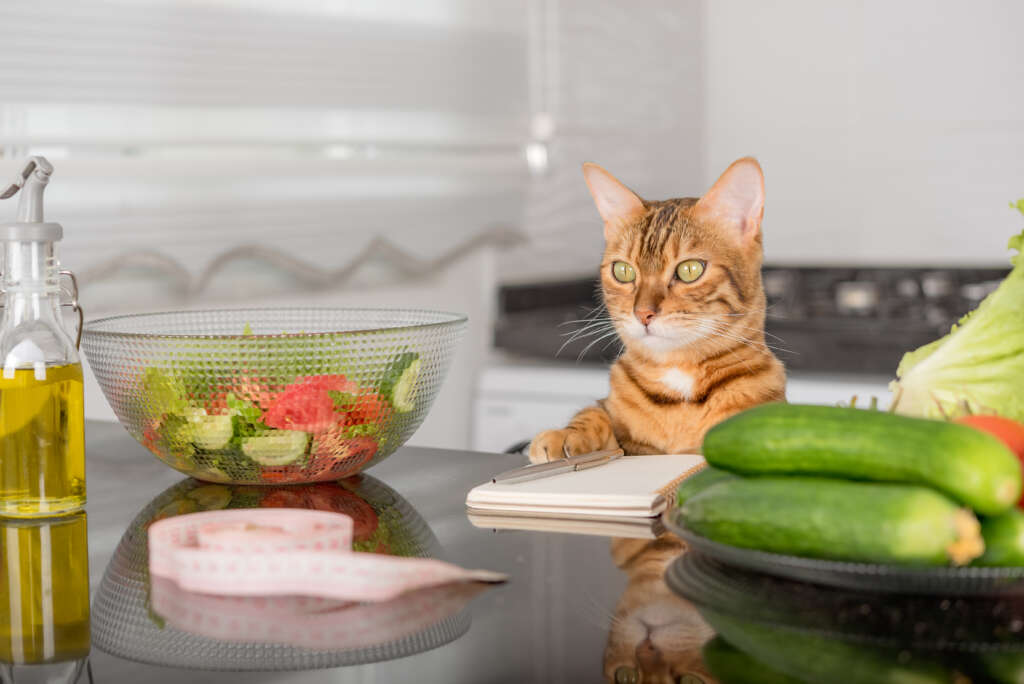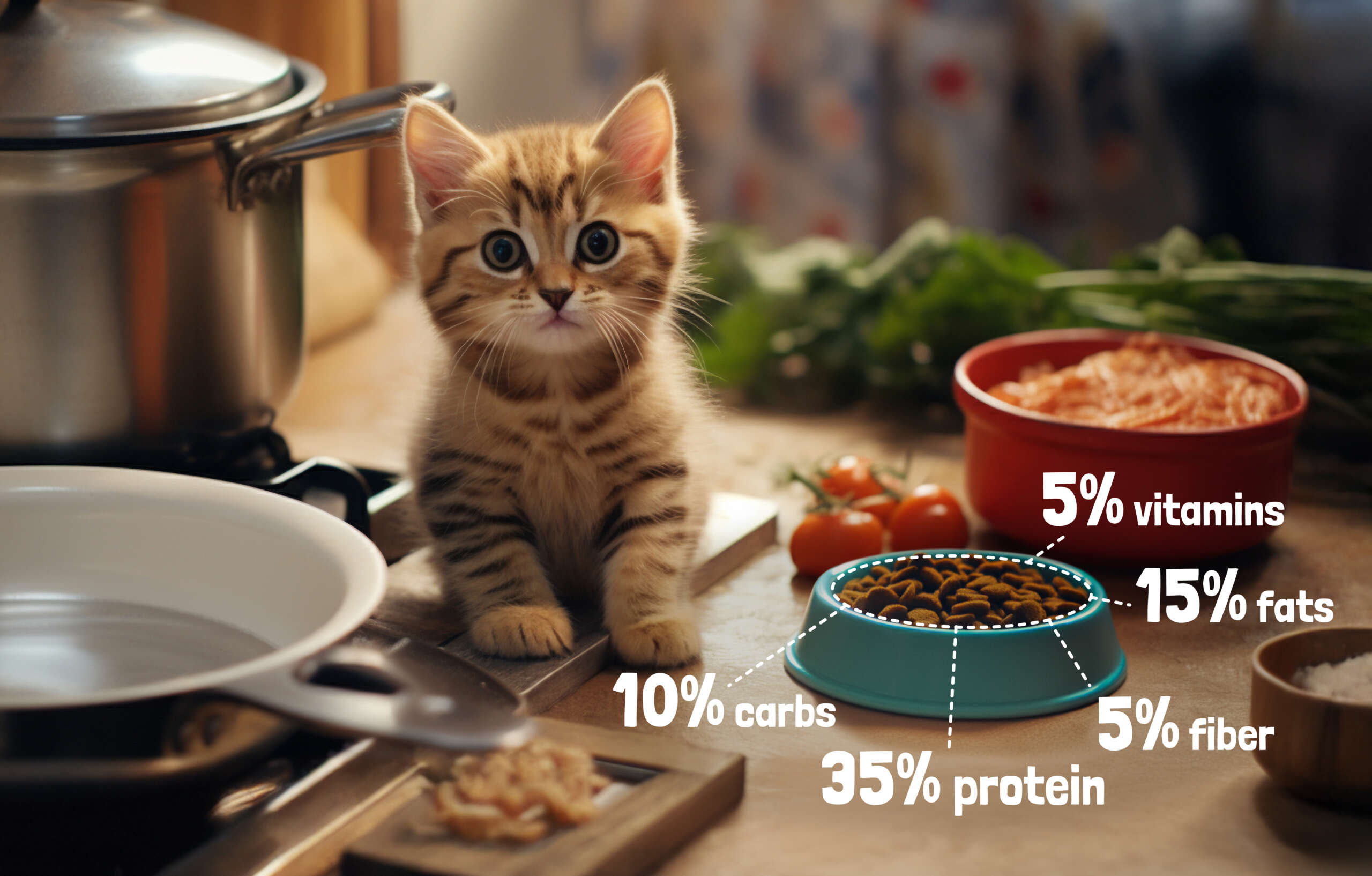Share This Article
Do you know that choosing the right food can add years to your cat’s life? As a caring pet owner, it’s crucial to understand the details of feline dietary needs. With so many options, finding the best diet for cat health and nutrition can be tough.
Cats need a lot of nutrients for good health, including vitamins, amino acids, and fatty acids. Sadly, many cats are overweight, showing how crucial it is to watch calorie intake. The Feline Nutrition Expert Subcommittee of the AAFCO sets standards for cat food, making you wonder if your cat’s food is right for them.
We’re going to explore the world of feline nutrition together. We’ll look at commercial foods, compare dry and wet food, talk about making your cat food, and discuss healthy treats. Our goal is to give you the knowledge to make your cat’s diet the best it can be. Get ready to learn how to feed your cat right.
Understanding Your Cat’s Nutritional Needs
As obligate carnivores, cats need a lot of meat in their diet. They have special nutritional needs that are different from humans and other pets. They need a diet full of proteins with the right amino acids for their health.
This diet helps keep their fur and muscles healthy and supports their organs.

Cats used to live in the desert, so they don’t drink much water. But, they still need clean, fresh water to stay healthy. Pet owners should put water bowls in different places to encourage their cats to drink more.
What cats need to eat changes based on their age and health. Kittens need lots of calories and nutrients for growth. Senior cats need food that helps with joint and brain health.
Feeding your cat a balanced and high-quality diet is crucial. It’s more than just filling a bowl. It affects their health and happiness for years to come.
Feeding your cat is about more than just stopping hunger. It’s about giving them a diet that makes them healthy and happy. By focusing on necessary nutrients and what obligate carnivores need, you can make your cat’s life better.
Evaluating Commercial Cat Food Options

When looking at commercial cat foods, pet owners must choose between dry food, semi-moist food, and canned food. Each type has its benefits and things to consider for your cat’s health. A cat food guide can help, but knowing more ensures a complete and balanced diet.
Dry food is easy to use and lasts a long time, making it a top pick for many cat owners. It has only 10-12% water, though, which might not help with hydration. Canned food, with its 70-80% water, is great for keeping your cat hydrated, which is key for a healthy urinary tract. But, it’s also pricier.
When picking the right food, look at the labels and know what the ingredients mean. For example, muscle meat and by-products are both protein sources, but they’re not the same. Muscle meat is better for your cat’s health.
For cats with special health needs, like kidney disease, there are special foods. Dave’s Restricted Diet is one, with controlled phosphorus levels. It focuses on high-quality animal proteins, which cats need, unlike plant proteins which aren’t as good for them.
Many cat owners think “grain-free” means cat food is better, but some of these foods still have a lot of carbs. Cats are meant to eat meat, not grains. So, it’s best to choose foods with less carbs and more animal protein.
Feral cats eat a diet high in protein and low in carbs, which is good for them. Research shows that wet cat foods with lots of protein and few carbs can help prevent health problems. These problems include urinary tract disease and chronic stomach issues seen in cats eating mostly dry food.
A complete and balanced diet is key for a cat’s health. So, whether you choose dry kibble, semi-moist food, or wet food, make sure it meets AAFCO standards. Every part of the food, from hydration to protein sources, affects your cat’s health and happiness.
Pros and Cons of Dry, Semi-Moist, and Canned Cat Foods
Choosing the right food for your cat can be tough. Pet owners must weigh the pros and cons of dry, semi-moist, and canned cat foods. Each type has its benefits and drawbacks for a balanced cat diet. Knowing these can help make sure your cat gets the nutrients they need and enjoys their food.
Dry cat food is great because it’s calorically dense. Cats eat less but still get enough nutrients. It’s also easy to store for a long time without worrying about it going bad. But, it only has 6-10% water, unlike canned foods which have 70-85%. This means cats might need extra water to stay hydrated.
Semi-moist cat food is a mix between dry and canned options, with about 25-34% water. It tastes better than dry food and doesn’t need to be kept cold. But, it can spoil faster once opened. It has moderate protein but more carbs, which might not be good for weight control.
Canned cat food is very moist and tastes great, making it perfect for picky eaters. It helps with hydration and is great for cats with kidney disease. But, it must be stored properly after opening, usually in the fridge.
Combining dry and wet food can be a good way to give your cat a balanced cat diet. This mix offers the taste and moisture of wet food with the nutrition of dry food. But, it’s important to watch how much you feed them to avoid overfeeding.
Choosing between dry, semi-moist, and canned cat foods depends on your cat’s health, eating habits, and how well you can store food. It’s a good idea to talk to a vet to find the best diet for your cat’s needs.
How to Choose a Balanced and Complete Cat Diet
Choosing the right cat diet can be tough with so many options. It’s key to talk to experts like the Feline Nutrition Expert Subcommittee. They make sure cat food meets AAFCO standards for a balanced diet. This means the food has all the needed nutrients in the right amounts.
When picking a diet for your cat, consider whether it’s dry or wet food. Experts say cats need lots of animal proteins and fats but not many carbs. This diet is close to what they eat in the wild and keeps them healthy. Cats should eat foods with at least 40% protein and not too many carbs to avoid obesity and diabetes.
It’s important to look at the water content in cat food too. Cats get a lot of water from their food. Canned foods have a lot of water, which helps them stay hydrated and lowers the chance of urinary problems. Cats are different, so some like dry food better than wet, and vice versa.
Feeding cats from separate bowls helps you keep an eye on how much they eat. This is key for their health and weight. Always read labels to make sure the food meets the Feline Nutrition Expert Subcommittee and AAFCO standards.
Treats can be fun and good for your cat, but they shouldn’t make up more than 10-15% of their daily food. Choose treats that are as healthy as their regular food to avoid nutrient imbalances. Don’t give them raw meat or dairy, as these can be harmful.

Choosing the right diet is crucial for your cat’s long, healthy life. Talk to a vet to make sure the diet fits your cat’s age, health, and taste. Following expert advice and standards ensures your pet gets the best nutrition.
Navigating the Challenges of Home-Prepared Feline Diets
Preparing homemade diets for cats can seem like a caring way to feed your pet. But, it has risks and challenges. Pet owners struggle to get the right ingredient balance for their cat’s needs.
A 2019 study found most home-cooked cat food lacks important nutrients like taurine, vitamin E, and iron. These nutrients are key to a cat’s health. Without them, cats can get heart disease, neurological issues, and a weak immune system. It’s vital to add these nutrients carefully to avoid deficiencies.
Commercial diets are safer because they’re made by feline culinary specialists. They are complete and balanced. This makes them a better choice than homemade diets.
Preparing homemade diets can also lead to food-borne illnesses. Raw or stored wrong, ingredients can have harmful bacteria like Salmonella and E.coli. These can harm pets and people in the house. Commercial foods are safer because they follow strict safety rules and have preservatives.
If you want to make meals for your cat, talk to a vet or a feline culinary specialist. They can help plan a safe, nutritionally complete diet. You might need to add supplements to fix common home-cooked meal problems. Start changing your cat’s diet slowly to help them get used to new tastes and textures.
While making meals for your cat can be tempting, it’s not easy. Making sure your cat is healthy requires careful planning of homemade diets. It’s important to get the ingredient balance right for your cat to stay healthy.
Healthy Treat Options and Foods to Avoid
When thinking about healthy treats for your cat, remember to keep things in moderation and balanced. Treats can be a great way to bond with your pet, but they shouldn’t take over their diet. Cooked lean meats like chicken, without fatty skin, are good choices. They provide important proteins for your cat’s health.
Dr. Tina Wismer from the ASPCA recommends cooked salmon as a treat. It’s tasty for cats and packed with protein and omega-3 fatty acids. These are key for a shiny coat and healthy skin. Eggs are also a great option, offering proteins and B vitamins. And, steamed veggies like broccoli and carrots add fiber and vitamins.
It’s important to watch what your cat eats to avoid health problems. While spinach is good for cats, it’s not good for those with bladder stones, says Dr. Wismer. Cantaloupe is safe for cats too, but remember to keep treats small to avoid obesity. Dr. Wismer advises that treats should make up less than 10% of a cat’s diet, ideally no more than 20 calories.
On the flip side, some foods are bad for cats. Foods safe for humans can be toxic to cats, like onions, grapes, chocolates, or anything with xylitol. It’s key to know what your cat can and can’t eat, especially since they might be allergic to certain proteins. By sticking to these guidelines and choosing protein-based treats, you can keep your cat happy and healthy.


